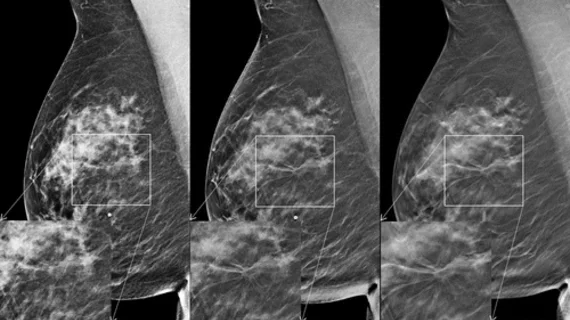DBT guidance saves time, reduces exposure during breast calcification biopsy
Breast biopsies guided via digital breast tomosynthesis rather than with digital mammography yield comparable results while also saving time and reducing patients’ radiation exposure.
That’s according to a new analysis that compared the two techniques in 1,310 patients from May 2017 to December 2021. Experts found that opting for DBT-guided biopsy of suspicious breast calcifications could shave up to five minutes off the total procedure time and decrease the number of exposures needed by nearly 10 acquisitions.
The analysis is published in the American Journal of Roentgenology. There, Derek L. Nguyen, MD, of Johns Hopkins Medicine, and co-authors shared the importance of comparing the two techniques for calcification biopsies specifically.
“Suspicious calcifications are the most common imaging finding associated with ductal carcinoma in situ (DCIS) and have a broad PPV for malignancy,” the authors explained. “Prior literature has demonstrated an improvement in targeting and sampling of noncalcified lesions (asymmetries, masses, and architectural distortion) by DBT-guided biopsy compared to traditional DM-guided biopsy.”
Studies comparing the methods’ efficacy for calcifications are limited, the authors shared, adding that those that did touch on the topic were hindered by small sample sizes.
For this study, the experts assessed a total of 1,354 9-gauge vacuum-assisted core biopsies—384 using DM guidance and 1,006 using DBT— from a single institution. DBT procedure time was lower than DM times, at 14.9 ± 8.0 minutes compared to 24.7 ± 14.3 minutes. The number of required exposures for DBT guidance was also lower, at 4.1 compared to 9.1, regardless of the radiologist completing the procedure. The researchers shared that the benefits did not come at the expense of performance, noting that malignancy and high-risk lesion upgrade rate did not differ significantly.
"The use of DBT-guided rather than DM-guided biopsy technique can potentially reduce patient discomfort and radiation dose without affecting clinical outcomes. The findings provide support for radiologists in transitioning from DM-guided to DBT-guided biopsy as a primary technique for sampling suspicious calcifications.”
The study abstract can be viewed here.

